
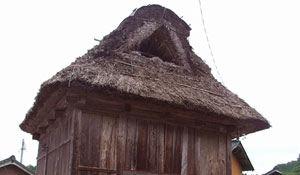 |
 |
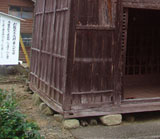 |
At handmadejapan.com we have been introducing various skilled handmade crafts since 2000. We have sort to expose the essence of those crafts which are characterized and deeply rooted in the areas where the craftspeople live, are affect by local climate and history. And at the same time there has been a chance to enjoy the individual qualities of ceramics both rustic and fine, cloth, paper and items made of bamboo, too. In a series of ten articles under the heading of Noto: Unsung Treasures, the architect Shinji Takagi, who was born and raised in Wajima in Ishikawa prefecture, seeks to identify some of the interesting buildings and their background, old local customs and various pieces of engaging landscape, all of which might not make it into a tourist guide but are nevertheless of considerable interest. (These articles were originally published in Japanese in volume 6~15 of the quarterly magazine Noto under the title of Sarigenai Fukei.) Shinji Takagi-Architect Born in Wajima in 1942. Worked on many projects using local materials and true lacquer for shops, houses and a variety of interior design schemes. Principal work includes Yuyado Sakamoto in Suzu; the repair and renovation of the true lacquer craftsman's house, Nurishi no Ie in Wajima; Meiso no Yakata in Toga, Toyama prefecture; the store Kombuya Shirai in Nanao and Kanazawa; a store selling Japanese candles, Takazawa Shoten in Nanao. Member on the Wajima City Council for the Protection of Cultural Properties Committee. Director of the NPO, Ishikawa Reed Thatch Culture Study Group. |
Having previously trained and worked in an architectural practice in Kanazawa, it is now already 36 years since I returned to the place of my birth and set up my own architectural office in Wajima, located on the northern coast of the Noto peninsular. Jutting out into the Sea of Japan, Noto is undeniably one of the forgotten corners of the nation but for me, of course, I was returning to familiar surroundings. Nevertheless, there was a sense of being swept along by circumstances as I dedicated myself to my work. Almost without noticing, changes were taking place in various things around me and I began to feel that the individual character of the area was withering away. In actual fact, of course, seen in the light of the changes taking place in Japan as a whole, Noto has managed to retain a good deal of its local character and culture. Back toward the end of the 19th century Percival Lowell (1855~1916), who was a noted American astronomer, mathematician and businessman wrote Noto: An Unexplored Corner of Japan. Then Lafcadio Hearn (1850~1904) who took up residence in Japan, wrote much along with other authors on the archipelago and yet Noto still seems to have been something of an unexplored backwater. With the period of rapid economic growth in Japan beginning in the second half of the 1960s, the young were drawn toward the main urban connotations and many regions were faced with depopulation. Then with the progressive rationalization and resulting pursuit of convenience in the cities, many people began to do their shopping at a supermarket or convenience store on a regular basis and as a consequence the charm of the morning street markets, which had been in existence for hundreds of years, was once again recognized. Ironically, it was during this period of rapid growth in Japan that there was a surge of interest in “Unexplored Noto” and a considerable increase in the number of domestic tourists visiting this peninsular where the resident population was dwindling. There is no doubting the fact that Noto has changed. But there are, nevertheless, still many virtually untouched and largely forgotten small buildings and structures where people would gather, nestling in corners of the rural landscape of Noto. It is in search of these unsung treasures that I sometimes set off when the inclination takes me. |
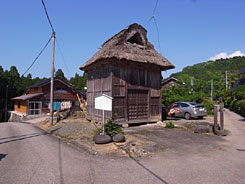 |
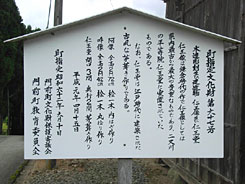 |
| Nio-do - Hall of the Guardians After leaving Anamizu and heading toward Wajima, the road divides in Omata. Then, after turning left toward Monzen we come to the Taira bus stop near Futamatagawa. Just after the bus stop we then turn right and a small, old reed-thatched building comes into view over to the right. As we approach the building we find that there are a number of large tree stumps around it. Judging by the diameter of these stumps the trees must have been of a considerable height. With the passing years, they grew tall and in 2002 they were felled for fear that they might blow down. The Nio-do tself was built during the Edo period (1600~1868) and houses two guardian warrior figures. One, called Azo is a demon-like figure with his mouth open. The other is called Unzo and represents a warrior with his mouth shut. Both are common features at the entrance to Buddhist temples. These two were constructed in the Kamakura period (1185~1333) and were originally enshrined in a Hall of Guardians at the Futamatagawa Shingon sect temple before they were moved to their present location. Sadly records concerning these figures were lost to fire at the temple but, judging by their height, the monastery itself must have been of considerable size and they are indeed the largest in the whole of Ishikawa prefecture of which Noto is a part. This Nio-do has a plan some 3.5 meters square and has an extremely simple exterior. The walls are of a daubed earth construction over a woven “wattle” of split bamboo and those parts of the walls which are subjected to the most severe weathering are faced with vertical boards. The eaves of the reed-thatched roof are shallow and the small undressed stone foundations help to give the building an air of instability. In the earthquake which struck the Noto peninsular in March 2007 however, the building came through it unscathed. |
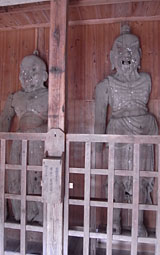 |
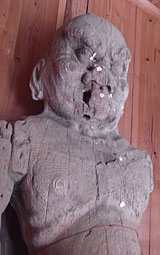 |
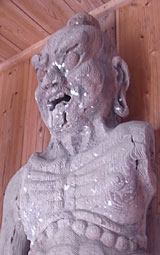 |
| Futamatagawa is the largest community in the area and in the past large numbers of the villagers would have gathered at the Nio-do under the cedars to enjoy seasonal festivals involving the carrying of a Mikoshi or portable shrine and such things as a Lion Dance performed with a large puppet lion head manipulated in a similar way to a pantomime horse. The reed-thatched roof will have been re-thatched or repaired any number of times by the locals since the building was erected but, due to the depopulation of the area, such work sadly no longer takes place. I have heard that because there are no funds available locally for such repairs there are those who would like to see the building taken down and a new one put up in its place. It's quite common for us all to only realize the significance of something once it's gone. But surely we should be taking a more careful look at what we have been left by our ancestors and those that came before us while it still exists. That's why I am dedicated to the idea of trying to take stock and make sense of all of the small gems which remain-the unsung treasures of Noto.* |
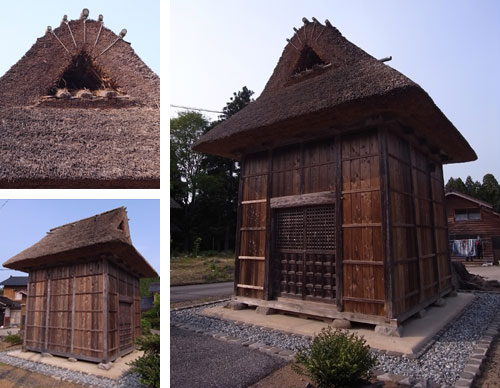 |
| (2014/6 yuko yokoyama) |
|
(C)Copyright 2004 Jomon-sha Inc, All rights reserved. |